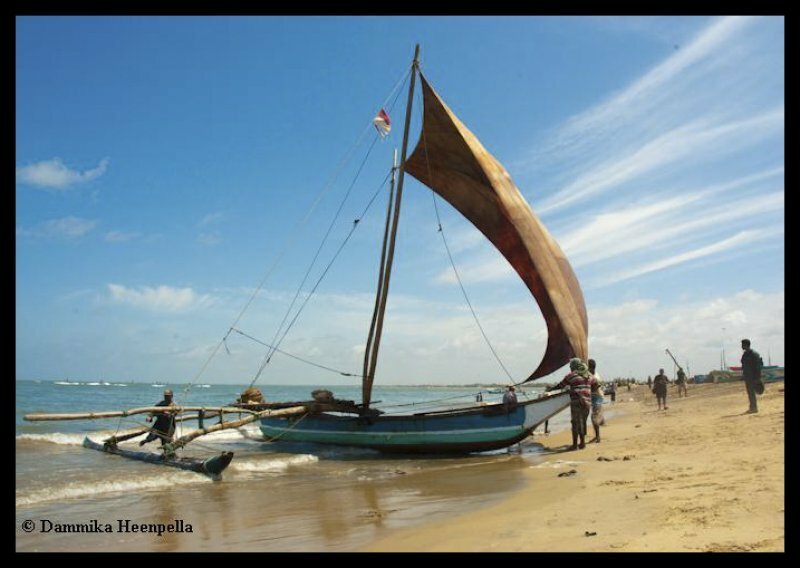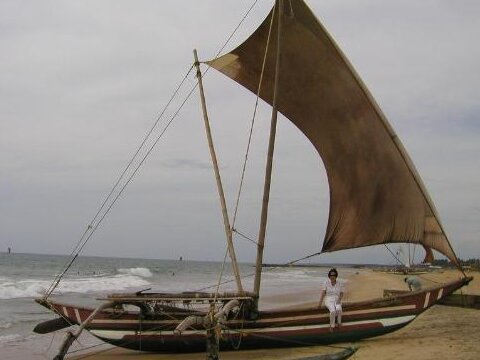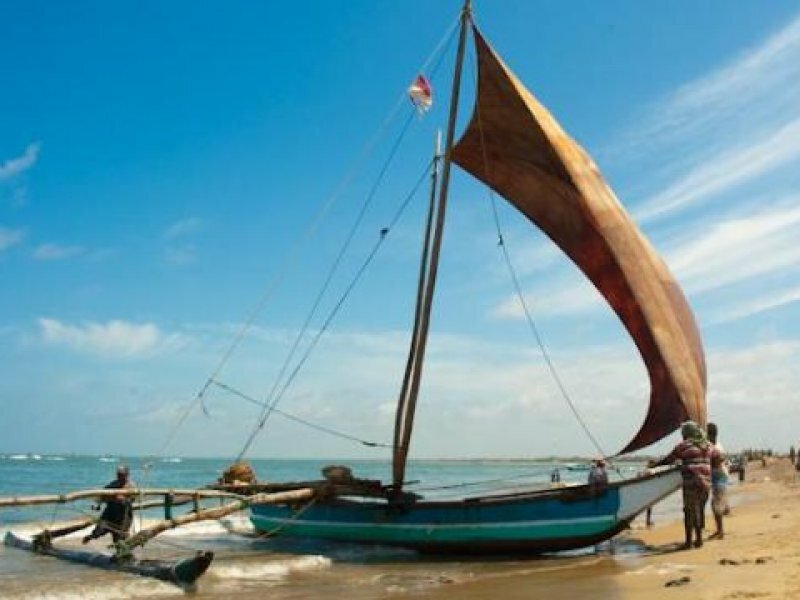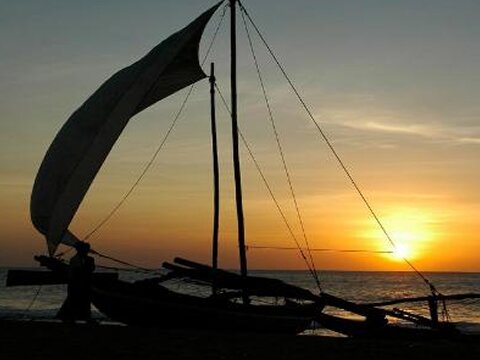Construction
There are two distinct features of the oruwa that set it apart from all other craft. It is not just the outrigger construction, whereby a pair of arched wooden spars connects and permanently fixes the outrigger itself to the hull.
A real unique feature is that the oruwas have two poles that serve as a single mast. At the end of every pole the corner of a rectangular sail is attached, and this sail is attached to the bow and the deck in a similar way as a standard foresail on a modern yacht.
From a distance the result appears like a huge foresail, something between a spinnaker and a genua, but attached to the top of the mast in a way you´ve never seen before. Some boats have a smaller sail more to the aft of the ship and this sail is attached to one of the poles the main mast consists of.
The result is a craft that appears to be radically different: a mainsail before the masts, a foresail behind it. The outrigger is always kept to the windward which means that what was the bow on one tack becomes the stern on the other tack. To prevent side-wards drift there is a leeboard midship.
There is a rudder in each end of the main hull. When the bow rudder is being raised the helmsman has to move from one end of the canoe to the other. The helmsman sits and steer the rudder with his foot.
The other remarkable and unique part of the construction of the oruwa in which this outrigger is constructed. The oruwa shipwright literally uses a needle and a thread to stitch his boat together.
To join the different parts of the boat, holes are drilled along the edges, the seam is covered with coconut matting and then the pieces are simply sewn together by means of a basic cross-stitch. There is no iron bolts or nails in the traditional oruwa.
Stitching as a way to construct a boat is an age old method, also used by craftsmen building the boats used by the ancient pharaohs of the ancient Egyptians. Dhows were put together in a similar way. The oruwa is certainly one of the last survivors of this method.
If you manage to find a shipwright in Negombe constructing a wooden oruwa the traditional way, with a needle and a thread, then you are witness to something unique. Another typical feature of the oruwa is its red sail. The sails are dyed to so that the fabric becomes more resistant against rot.

Oruwa, Negombe, Sri Lanka, 2005 © Dammika Heenpela
Today the main hull of the oru is made from fibreglass, but the basic shape is identical to the traditional wooden oruwa. What has not changed are the wooden outrigger and the arms that connect the wooden outrigger to the main hull. The outrigger arms are curved and made from a strong tree trunk with thinner battens lashed on to strengthen it and give flexibility. Fixation of the arms to the main hull is with coir rope lashings which give the required elasticity of the whole construction.
The sailing rig of the bala-oruwa is the so-called double sprit rig with two bamboo poles that serve to hold the sail extended. At the end of each pole the top corners of the rectangular sail are attached. The top ends of the poles are braced with ropes leading aft to the stern. One of the lower corners of the sail is attached to the bow in a similar way as a standard foresail on a modern yacht.
The sheet is attached to the other corner to control the sail. From a distance the result appears like a huge foresail, something between a spinnaker and a Genua, but rigged in a way you have never seen before. Some boats have a smaller triangular sail aft of the mainsail. The result is a craft that appears to be radically different: A mainsail before the masts, a foresail behind it.
The outrigger is always kept to windward which means that what was the bow on one tack becomes the stern on the other tack. To prevent side-wards drift there is a leeboard fixed midship that can be raised and lowered to adjust the balance of the oruwa when sailing.
There is a rudder in each end of the main hull which can be raised and lowered. To experience the skill of the crew in tacking (or rather shunting) the oruwa is a unique experience for yachtsmen from other parts of the world.
The oruwa is first turned so that the wind comes in at a 90 degree angle. The forward corner of the sail is loosened from the bow and brought back between the two mast poles to what was the stern but will become the new bow. The pole rope braces are also shifted to the old bow which will become the new stern.
The helmsman raises what was the rudder and moves along the canoe to the other end and lower what will become the new rudder. He sits and steers the rudder with his foot, partly by lowering the rudder more or less into the sea to change the balance together with the centre leeboard, and partly by turning it using a short tiller.






